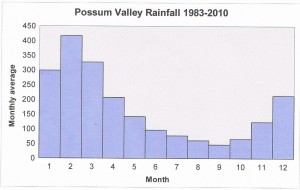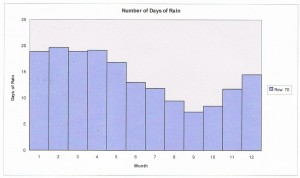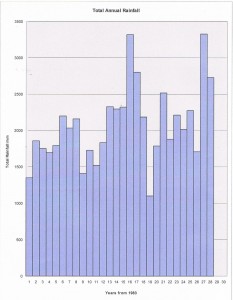Possum Valley Rainfall
In this part of Queensland the rainfall can vary dramatically within a few kilometres. Only 10 kms to the west at Kaban the rainfall is half what we enjoy at Possum Valley. About 30 kms to the east on the exposed flanks of the mountains, the rainfall is as much as four times Possum Valley averaging over 8m a year. The rainfall is distinctly seasonal with February being the wettest and September being the driest.
I have collected rainfall data for possum Valley since 1983 and the results are charted below.
The yearly average for this period was 2006 mm. I regret that I was not recording the rainfall during my first wet season at Possum Valley. In the first 5 days of the year, we had over 2000mm of rain. That reading is the official one borrowed from Millaa Millaa. I tried to use a bucket to get some idea, but every time I looked, it was overflowing. It was caused by a powerful cyclone stationary in the Gulf of Carpenteria. The only bit of road open in North Queensland was Atherton to Mareeba and that was not recommended. A couple of guys were arrested for water-skiing down one of the major streets in the center of Cairns.
Though the rainfall totals are clearly seasonal, the number of wet days is less distinct. This is because the wet season rain in summer is likely to be heavier that the dry season rain in winter.
1999 was the wettest year with 3318 mm, and 2002 was the driest with a mere 1100 mm. Topaz, just about 15 km from here, is the wettest inhabited place in Oz and enjoys an annual rainfall of 4831 mm pa, but fails to get the golden gumboot award as it is not a town, but a district of dairy farms. In a wet year Topaz can get over 8500 mm.
The hottest temperature ever recorded at Possum Valley was the week before Christmas 1995 was 33°C. At the time it was a sweltering 44.5°C in Cairns. We expect a few cold nights of frost in the year and the coldest temperature ever recorded in Possum Valley was -15°C. That was cheating by laying the thermometer on the ground. I expect the air temperature was a moderate -10°C or so. That was more than 25 years ago when there was far less regrowth for protection, and is unlikely to be repeated.
The frosty nights are usually followed by fine clear days.


